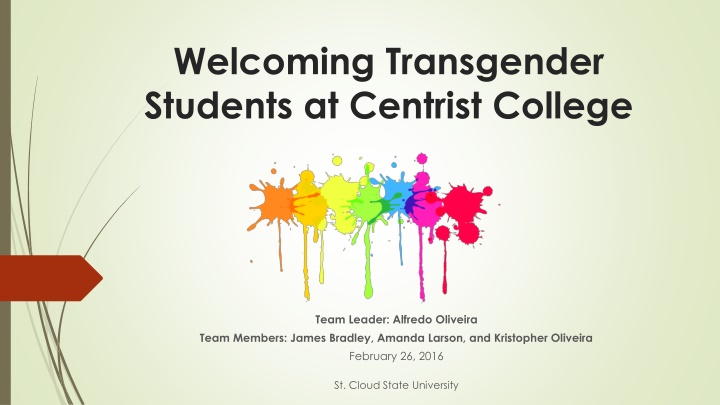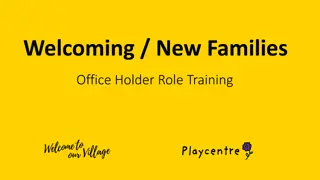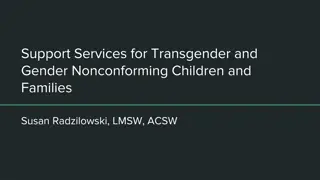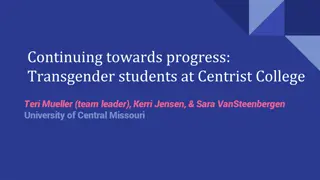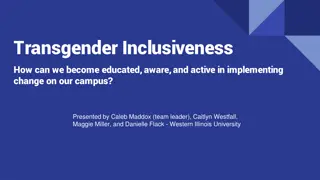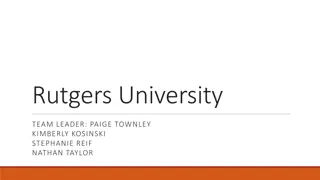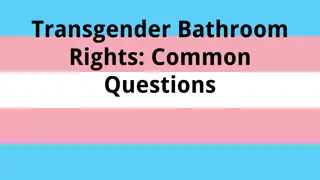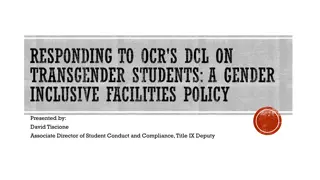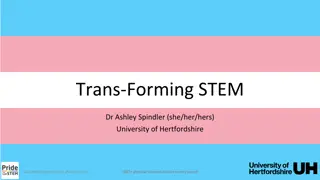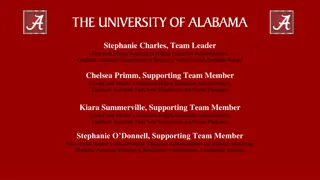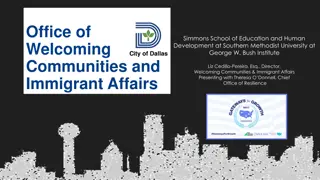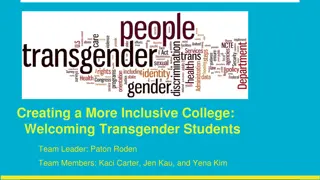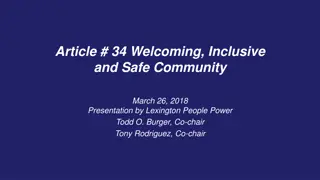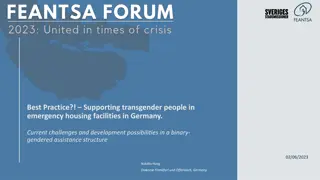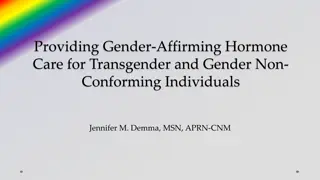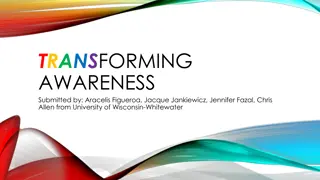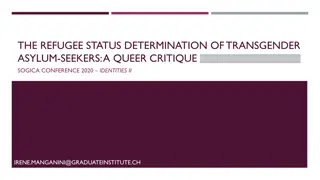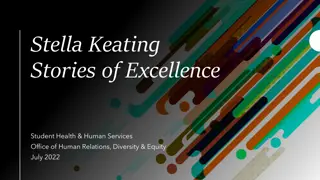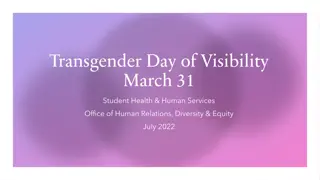Welcoming Transgender Students at Centrist College
"Team at Centrist College led by Alfredo Oliveira promotes inclusion and support for transgender students. Learn about their efforts in creating an affirming environment on campus."
Download Presentation

Please find below an Image/Link to download the presentation.
The content on the website is provided AS IS for your information and personal use only. It may not be sold, licensed, or shared on other websites without obtaining consent from the author.If you encounter any issues during the download, it is possible that the publisher has removed the file from their server.
You are allowed to download the files provided on this website for personal or commercial use, subject to the condition that they are used lawfully. All files are the property of their respective owners.
The content on the website is provided AS IS for your information and personal use only. It may not be sold, licensed, or shared on other websites without obtaining consent from the author.
E N D
Presentation Transcript
Welcoming Transgender Students at Centrist College Team Leader: Alfredo Oliveira Team Members: James Bradley, Amanda Larson, and Kristopher Oliveira February 26, 2016 St. Cloud State University
Welcome! Introductions Preferred Name Preferred Pronoun i.e.: she/her/hers, he/him/his, they/them/theirs Department/Office and Position Ground Rules Let s turn this into a Brave Space, not just Safe Space Be respectful Expand your mind set to absorb the information Ask questions! "An open mind leaves a chance for someone to drop a worthwhile thought in it" - Unknown
Overview of the Trans* Community Trans* is an umbrella term that encompasses those who identify as transgender, transsexual, cross-dressers, drag queens/kings, gender radicals, and gender-queers to name a few. This list of identities is not exhaustive and many college students identify in different terms, especially within and between cultures. Transgender is a term used to describe people whose gender identity differs from the sex the doctor marked on their birth certificate (GLAAD, 2016). Gender identity is a person's internal, personal sense of being a man or a woman (or someone outside of that gender binary) (GLAAD, 2016). Sex is the classification of people as male or female. At birth infants are assigned a sex, usually based on the appearance of their external anatomy (GLAAD, 2016). According to Stryker s theory (2008) gender is historical, temporal, geographical, cultural, contingent, and contextual, whereas sex is considered scientifically immutable and fixed. It s also important to note that gender identity and sexual orientation are not the same, and do not predict each other.
Overview of the Trans* Community Gender Identity exists on a continuum. Gender Identity is historical, temporal, geographical, contingent and contextual (Stryker, 2008). Killermann, S. (n.d.). The Genderbread Person v3 | It's Pronounced Metrosexual. Retrieved February 18, 2016, from http://itspronouncedmetrosexual.com/2015/03/the-genderbread-person-v3/
Barriers and Challenges These are just a few common issues the Trans* students face on campus: A national survey, conducted by McKinney (2005), showed that trans* students have the following negative experiences in college: minimal faculty and staff education and training on trans* issues, minimal programming about the trans* community, a lack of campus resources for trans* students, poor counseling services, and the inability for healthcare to meet the needs of trans* students. Sex-segregated living space, locker rooms, and bathrooms. Sex-segregated language on applications/forms, records, and pronouns. Lack of healthcare & insurance coverage (i.e. sex reassignment & hormones). Isolation, rejection, discrimination from others. (Clark, Ellis, Peel, and Riggs, 2010).
Best Practices for Trans* Inclusivity on College Campuses Required Staff Training Sessions Preferred Name Policy LGBT Resource Center Gender-neutral Housing and Restroom Pride Living Community Inclusive Language on Forms
Centrist Colleges Current Practices LGBT Resource Center Great visibility in the student union; easily accessible Safe space trainings for students, faculty, and staff Preferred name policy Affects class rosters, e-mails, and online platform (D2L Brightspace). Preferred name on student and staff IDs. Inclusive language on college forms Pride Living Community
Centrist Colleges Growth Opportunities Preferred pronouns on class rosters All-gender restrooms Guestspeaker(s) to campus Single room priority Workshops on transgender issues Updating non-discrimination policies
Strategic Action Plan 2016-2020 Support Services Project: Promoting Advocacy and Creating Support Groups Campus Partners: LGBT Resource Center, University Program Board, Department of Campus Involvement, Counseling and Psychological Services, Student Health Services, Residence Hall Association, and Student Government. Action Steps Training for faculty, staff, administrators, and counselors. Increase the number of faculty and staff who complete Safe Space trainings. Add a Transgender 101 workshop starting Spring 2017. Programming efforts to increase awareness Bring a Transgender speaker Ryan Sallans FTM to campus next Freshmen Orientation. Develop a student support group through the LGBT Resource Center by Fall 2017.
Strategic Action Plan 2016-2020 Administrative Project: Updating College Forms and Policies. Campus Partners: LGBT Resource Center, Records and Registration, Information Technology Services, and Student Government. Completion Goal: Implementation Fall 2017 Action Steps Inclusive language on forms, records, etc. Give students the opportunity to choose Other as Gender. There is a difference between Biological Sex and Gender . Preferred pronoun on student and staff IDs. Updating non-discrimination policies to include gender identity and expression.
Strategic Action Plan 2016-2020 Student Life & Development Project: Gender-neutral housing, bathrooms, and locker rooms. Campus Partners: LGBT Resource Center, Department of Residential Life, Finance and Facilities Management Team, Strategic Planning & Steering Committees, and Student Government. Action Steps Add gender-neutral housing, restrooms, and locker rooms to the Campus Comprehensive Facilities Plan. Gender-neutral housing within each residence hall Gender-neutral locker room in the campus fitness center completed by 2018. Gender-neutral restrooms in all academic and other student buildings completed by 2020.
Outcomes, Implications & Considerations Budget limitations for all-gender restrooms Events Enrollment and capacity considerations for a single room priority Students falsely identifying Workshop/program attendance Campus cultural shift Student, faculty, and staff backlash
Outcomes, Implications & Considerations Retention Students who feel connected and supported by our institution will be more likely to stay (Tinto, 1993). Identity Development Bilodeau & Renn (2005) found that identity development is a continual process and our role as student affairs professionals is to support trans students in ongoing self-work surrounding personal identity.
Thank you. Questions? Centrist College Lesbian, Gay, Bisexual, and Transgender Center Atwood Student Union, 112 E: lgbt@centrist.edu O: (651)604-7112
References Beemyn, B. G., Domingue, A., Pettitt, J., & Smith, T. (2005). Suggested Steps to Make Campuses More Trans- Inclusive. Journal of Gay & Lesbian Issues in Education,3(1), 89-94. Beemyn, B., Curtis, B., Davis, M., & Tubbs, N. J. (2005). Transgender issues on college campuses. New Directions For Student Services, (111), 49-60. Bilodeau, B. L., & Renn, K. A. (2005). Analysis of LGBT identity development models and implications for practice.New Directions For Student Services, (111), 25-39. Clarke, V., Ellis, S.J., Peel, E., & Riggs, D.W. (2010). Lesbian Gay Bisexual Trans & Queer Psychology: An Introduction (pp. 88-90). New York: Cambridge University Press Killermann, S. (n.d.). The Genderbread Person v3 | It's Pronounced Metrosexual. Retrieved February 18, 2016, from http://itspronouncedmetrosexual.com/2015/03/the-genderbread-person-v3/ Marine, S.B., & Catalano, D.C.J (2015). Engaging trans* students on college and university campuses. In Quaye, S.J., & Harper, S.R. (Eds.), Student engagement in higher education: theoretical perspectives and practical approaches for diverse populations (pp. 135-145). New York: Taylor & Francis. McKinney, J. (2005). On the margins: a study of the experiences of transgender college students. Journal Of Gay & Lesbian Issues In Education, 3(1), 63-76 14p. Schneider, W. (2010). Where Do We Belong? Addressing the Needs of Transgender Students in Higher Education. Vermont Connection, 3196. Stryker, S. (2008). Transgender history. Berkeley, CA : Seal Press : Distributed by Publishers Group West, c2008. Tinto, V. (1993). Leaving College: Rethinking the Causes and Cures of Student Attrition. (2nd ed.). Chicago: University of Chicago Press. Transgender FAQ. (2013). Retrieved February 18, 2016, from http://www.glaad.org/transgender/transfaq
